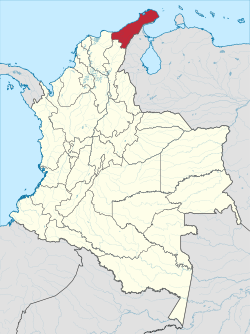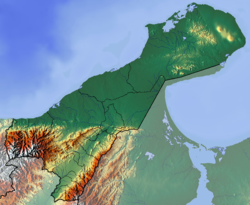
Back Guajira (departement) Afrikaans إدارة لا غواخيرا Arabic La Guajira AST Guakėras departaments BAT-SMG Гуахира Bulgarian La Guajira (departamant) Breton La Guajira Catalan Departamento de La Guajira CEB La Guajira Czech La Guajira German
La Guajira Department
| |
|---|---|
 | |
| Anthem: Himno de La Guajira. | |
 La Guajira shown in red | |
 Topography of the department | |
| Coordinates: 11°33′N 72°54′W / 11.550°N 72.900°W | |
| Country | |
| Region | Caribbean Region |
| Established | July 1, 1965 |
| Capital | Riohacha |
| Government | |
| • Governor | Jairo Aguilar (2024-2027) (Radical Change) |
| Area | |
• Total | 20,848 km2 (8,049 sq mi) |
| • Rank | 25th |
| Population (2018)[1] | |
• Total | 880,560 |
| • Rank | 20th |
| • Density | 42/km2 (110/sq mi) |
| GDP | |
| • Total | COP 22,263 billion (US$ 5.2 billion) |
| Time zone | UTC-05 |
| ISO 3166 code | CO-LAG |
| Municipalities | 15 |
| HDI (2019) | 0.695[3] medium · 31st of 33 |
| Website | www.laguajira.gov.co/ |
La Guajira (Spanish pronunciation: [la ɣwaˈxiɾa][4]) is a department of Colombia. It occupies most of the Guajira Peninsula in the northeast region of the country, on the Caribbean Sea and bordering Venezuela, at the northernmost tip of South America. The capital city of the department is Riohacha.
Various indigenous tribes have populated the arid plains of the region long before the Spanish expeditions reached the Americas. In 1498, Alonso de Ojeda sailed around the peninsula of La Guajira, but the first European to set foot in what is known today as La Guajira was the Spanish explorer Juan de la Cosa in 1499. During the colonial era, the territory of La Guajira was disputed by the governors of Santa Marta and Venezuela, owing to deposits of pearls. English pirates, Frenchmen, and Germans also fought for control of the territory.
Martin Fernandez de Enciso founded Nuestra Señora Santa María de los Remedios del Cabo de la Vela, the first colonial village in the territory. In 1535, Nicolás de Federmán refounded the settlement as the village of Riohacha, as a result of constant attacks by the Wayuu people. In 1544, it was moved to the site of the present-day city. In 1871, the region was separated from the Department of Magdalena, and La Guajira became a national territory in its own right. The Intendance of La Guajira was created in 1898.[5]
In 1911, the Colombian government created the Commissary of la Guajira. In the 1930s, numerous immigrants came to the area from the Middle East (Christian Arabs, Maronites in particular, and Shi'i Muslims) from Lebanon, Syria, Palestine and Jordan. They generally settled in the city of Maicao. In 1954, the Intendance of la Guajira was created again and Riohacha was declared a municipality. Finally, in 1964, the Department of La Guajira was created.[5]
The economy of the department depends on royalties from the coal mining at Cerrejón (producing 24.9 million tons of export coal in 2004), natural gas exploitation, and salt mines. A popular ecotourist destination is Cabo de la Vela, a small fishing village located on the headland of the peninsula in the Guajira desert.
- ^ "Censo Nacional de Población y Vivienda 2018". Departamento Administrativo Nacional de Estadística – DANE (in Spanish). Retrieved 25 October 2019.
- ^ "Producto Interno Bruto por departamento", www.dane.gov.co
- ^ "Sub-national HDI - Area Database - Global Data Lab". hdi.globaldatalab.org. Retrieved 2018-09-13.
- ^ In isolation, they are pronounced [la] and [gwaˈxiɾa] respectively.
- ^ a b Colombian Air Force: Guajira

